The Fabrication and Characterization of Self-Powered P-I-N Perovskite Photodetectors Using Yttrium-Doped Cuprous Thiocyanate
Abstract
1. Introduction
2. Experimental Method and Characterization
3. Discussion and Results
4. Conclusions
Author Contributions
Funding
Data Availability Statement
Conflicts of Interest
References
- Lin, B.; Fu, Z.; Jia, Y. Green luminescent center in undoped zinc oxide films deposited on silicon substrates. Appl. Phys. Lett. 2001, 79, 943–945. [Google Scholar] [CrossRef]
- Ahmad, B.E.; Mohamad, H.W.; Noha, G. Fibroblast growth factor-23 is independently associated with the left ventricular mass index in hemodialysis patients. Kasr Al Ainy Med. J. 2018, 24, 122. [Google Scholar] [CrossRef]
- Chu, J.; Wang, Z.; Guan, L.; Liu, Z.; Wang, Y.; Zhang, R. Integrated polarization dependent photodetector and its application for polarization navigation. IEEE Photonics Technol. Lett. 2014, 26, 469–472. [Google Scholar]
- Zhang, Q.; Chang, J.; Cong, Z.; Wang, Z. Application of quartz tuning fork in photodetector based on photothermal effect. IEEE Photonics Technol. Lett. 2019, 31, 1592–1595. [Google Scholar] [CrossRef]
- Zeng, Y.; Huang, H.; Zhao, X.; Ding, M.; Hou, X.; Zou, Y.; Du, J.; Liu, J.; Yu, S.; Han, K.; et al. Self-Powered a-SnO x/c-Ga2O3 Pn Heterojunction Solar-Blind Photodetector with High Responsivity and Swift Response Speed. IEEE Electron Device Lett. 2023, 44, 2003–2006. [Google Scholar] [CrossRef]
- Huo, T.-t.; Zhang, D.-d.; Shi, X.-l.; Pan, Y.; Sun, L.; Su, Y. High-performance self-powered photodetectors based on the carbon nanomaterial/GaAs vdW heterojunctions. Chin. Opt. 2022, 15, 373. [Google Scholar]
- Guo, D.; Su, Y.; Shi, H.; Li, P.; Zhao, N.; Ye, J.; Wang, S.; Liu, A.; Chen, Z.; Li, C.; et al. Self-powered ultraviolet photodetector with superhigh photoresponsivity (3.05 A/W) based on the GaN/Sn: Ga2O3 pn junction. ACS Nano 2018, 12, 12827–12835. [Google Scholar] [CrossRef]
- Wu, H.; Ma, C.; Zhang, J.; Cao, H.; Lin, R.; Bai, W.; Pan, Z.; Yang, J.; Zhang, Y.; Chen, Y.; et al. High-performance photodetectors with an ultrahigh photoswitching ratio and a very fast response speed in self-powered Cu2ZnSnS4/CdS PN heterojunctions. ACS Appl. Electron. Mater. 2021, 3, 4135–4143. [Google Scholar] [CrossRef]
- Pintor-Monroy, M.I.; Barrera, D.; Murillo-Borjas, B.L.; Ochoa-Estrella, F.J.; Hsu, J.W.; Quevedo-Lopez, M.A. Tunable electrical and optical properties of nickel oxide (NiO x) thin films for fully transparent NiO x–Ga2O3 p–n junction diodes. ACS Appl. Mater. Interfaces 2018, 10, 38159–38165. [Google Scholar] [CrossRef]
- Mahala, P.; Patel, M.; Ban, D.-K.; Nguyen, T.T.; Yi, J.; Kim, J. High-performing self-driven ultraviolet photodetector by TiO2/Co3O4 photovoltaics. J. Alloys Compd. 2020, 827, 154376. [Google Scholar] [CrossRef]
- Tsai, S.-Y.; Hon, M.-H.; Lu, Y.-M. Fabrication of transparent p-NiO/n-ZnO heterojunction devices for ultraviolet photodetectors. Solid-State Electron. 2011, 63, 37–41. [Google Scholar] [CrossRef]
- Patel, M.; Kim, H.-S.; Kim, J.; Yun, J.-H.; Kim, S.J.; Choi, E.H.; Park, H.-H. Excitonic metal oxide heterojunction (NiO/ZnO) solar cells for all-transparent module integration. Sol. Energy Mater. Sol. cells 2017, 170, 246–253. [Google Scholar] [CrossRef]
- Xu, Y.; Shen, H.; Li, Y.; Yue, Z.; Zhang, W.; Zhao, Q.; Wang, Z. Self-powered and fast response MoO3/n-Si photodetectors on flexible silicon substrates with light-trapping structures. ACS Appl. Electron. Mater. 2022, 4, 4641–4652. [Google Scholar] [CrossRef]
- Sarcan, F.; Doğan, U.; Althumali, A.; Vasili, H.B.; Lari, L.; Kerrigan, A.; Kuruoğlu, F.; Lazarov, V.K.; Erol, A. A novel NiO-based pin ultraviolet photodiode. J. Alloys Compd. 2023, 934, 167806. [Google Scholar] [CrossRef]
- Li, Y.; Wei, X.; Yang, Q.; Zhang, J.; Wang, W.; Dong, L.; Gao, B.; Li, C.; Sun, X.; Ma, Y. Fast-response self-powered flexible transparent ultraviolet photodetectors based on a CuO/ZnO nanowire array heterojunction. New J. Chem. 2023, 47, 6397–6404. [Google Scholar] [CrossRef]
- Serkjan, N.; Liu, X.; Abdiryim, T.; Liu, F.; Zhang, H.; Kadir, A.; Liu, Y.; Tang, X.; Cheng, Q. Organic-inorganic face-to-face ZnO NRs-based self-powered UV photodetectors: Heterojunction with poly (3, 4-ethylenedioxyselenophene) and enhanced responsivity by carbon quantum dots. Carbon 2023, 204, 387–397. [Google Scholar] [CrossRef]
- Luo, G.; Zhang, Z.; Jiang, J.; Liu, Y.; Li, W.; Zhang, J.; Hao, X.; Wang, W. Enhanced performance of ZnO nanorod array/CuSCN ultraviolet photodetectors with functionalized graphene layers. RSC Adv. 2021, 11, 7682–7692. [Google Scholar] [CrossRef]
- Zheng, Z.; Wang, W.; Wu, F.; Wang, Z.; Shan, M.; Zhao, Y.; Liu, W.; Jian, P.; Dai, J.; Lu, H.; et al. Flexible assembly of the PEDOT: PSS/exfoliated β-Ga2O3 microwire hybrid heterojunction for high-performance self-powered solar-blind photodetector. Opt. Express 2022, 30, 21822–21832. [Google Scholar] [CrossRef]
- Zhang, Y.; Cheng, X.; Tu, D.; Gong, Z.; Li, R.; Yang, Y.; Zheng, W.; Xu, J.; Deng, S.; Chen, X. Engineering the bandgap and surface structure of CsPbCl3 nanocrystals to achieve efficient ultraviolet luminescence. Angew. Chem. Int. Ed. 2021, 60, 9693–9698. [Google Scholar] [CrossRef]
- Wang, J.; Yang, F.; Ding, G.; Hong, X.; Yang, Q. Large Orthorhombic Polyhedral CsPbBr3 Nanocrystals for Ultrasensitive Photodetectors with Type-I Structures. Adv. Mater. Technol. 2023, 8, 2300252. [Google Scholar] [CrossRef]
- Chen, X.; Huang, S.; Nasiri, N. Facile fabrication of UV photodetectors using spin-coating flame-synthesized ZnO nanoparticles. ACS Appl. Nano Mater. 2024, 7, 3589–3600. [Google Scholar] [CrossRef]
- Kislov, A.N.; Zatsepin, A.F. Structural and vibrational properties of wurtzite ZnO with oxygen-deficient defects: Ab initio and potential-based calculations. Phys. Chem. Chem. Phys. 2023, 25, 16354–16362. [Google Scholar] [CrossRef] [PubMed]
- Wagner, R.S.; Ellis, W.C. Vapor-liquid-solid mechanism of single crystal growth. Appl. Phys. Lett. 1964, 4, 89–90. [Google Scholar] [CrossRef]
- Zhang, Y.; Cai, Z.; Hua, X.-N.; Sun, B. Novel One-Dimensional Organic–Inorganic Hybrid Halide Perovskite Material with Coexistence of High Phase Transition Temperature and Corresponding Dielectric Response. J. Phys. Chem. C 2024, 128, 3400–3407. [Google Scholar] [CrossRef]
- Zhong, J.; Zhang, L.; Chen, Y.; Kong, A.; Tan, Q.; Fan, J.; Peng, Y.; Liang, G.; Ku, Z. Enhancing Organic–Inorganic Perovskite Thin Film Crystallization via Vapor–Solid Reaction by Modifying PbI2 Precursors Films with Pyridinium Trifluoromethanesulfonate. Sol. RRL 2024, 8, 2400016. [Google Scholar] [CrossRef]
- Hossain, M.K.; Mohammed, M.K.; Pandey, R.; Arnab, A.; Rubel, M.; Hossain, K.; Ali, M.H.; Rahman, M.F.; Bencherif, H.; Madan, J. Numerical analysis in DFT and SCAPS-1D on the influence of different charge transport layers of CsPbBr3 perovskite solar cells. Energy Fuels 2023, 37, 6078–6098. [Google Scholar] [CrossRef]
- Zhou, Q.; Liu, X.; Liu, Z.; Zhu, Y.; Lu, J.; Chen, Z.; Li, C.; Wang, J.; Xue, Q.; He, F.; et al. Annual research review of perovskite solar cells in 2023. Mater. Futures 2024, 3, 022102. [Google Scholar] [CrossRef]
- Wang, Y.; Zhang, T.; Kan, M.; Zhao, Y. Bifunctional stabilization of all-inorganic α-CsPbI3 perovskite for 17% efficiency photovoltaics. J. Am. Chem. Soc. 2018, 140, 12345–12348. [Google Scholar] [CrossRef]
- Chen, W.; Zhang, J.; Xu, G.; Xue, R.; Li, Y.; Zhou, Y.; Hou, J.; Li, Y. A semitransparent inorganic perovskite film for overcoming ultraviolet light instability of organic solar cells and achieving 14.03% efficiency. Adv. Mater. 2018, 30, 1800855. [Google Scholar] [CrossRef]
- Wang, F.; Xu, H.; Huang, H.; Ma, Z.; Wang, S.; Peng, L.-M. Performance improvement induced by asymmetric Y2O3-coated device structure to carbon-nanotube-film based photodetectors. Appl. Phys. Lett. 2017, 111, 193105. [Google Scholar] [CrossRef]
- Jaffe, J.E.; Kaspar, T.C.; Droubay, T.C.; Varga, T.; Bowden, M.E.; Exarhos, G.J. Electronic and defect structures of CuSCN. J. Phys. Chem. C 2010, 114, 9111–9117. [Google Scholar] [CrossRef]
- Kumara, G.; Konno, A.; Senadeera, G.; Jayaweera, P.; De Silva, D.; Tennakone, K. Dye-sensitized solar cell with the hole collector p-CuSCN deposited from a solution in n-propyl sulphide. Sol. Energy Mater. Sol. Cells 2001, 69, 195–199. [Google Scholar] [CrossRef]
- Garnier, J.; Parize, R.; Appert, E.; Chaix-Pluchery, O.; Kaminski-Cachopo, A.; Consonni, V. Physical properties of annealed ZnO nanowire/CuSCN heterojunctions for self-powered UV photodetectors. ACS Appl. Mater. Interfaces 2015, 7, 5820–5829. [Google Scholar] [CrossRef]
- Ashtar, M.; Yang, J.; Yang, Y.; Al-Ahmary, K.M.; Cao, D. Improved photodetection performance of self-powered UV photodetector based on PZT/CuSCN heterojunction. Sol. Energy Mater. Sol. Cells 2024, 270, 112812. [Google Scholar] [CrossRef]
- Taleghani, N.M.; Heydari, Z.; Madani, M.; Nasiri, A.F.; Kolahdouz, M.; Abdy, H. Study of metal-Co/Zn-doped CuSCN contacts for efficient hole transport in perovskite solar cells. Opt. Mater. 2022, 133, 113009. [Google Scholar] [CrossRef]
- Liang, J.-W.; Firdaus, Y.; Azmi, R.; Faber, H.; Kaltsas, D.; Kang, C.H.; Nugraha, M.I.; Yengel, E.; Ng, T.K.; De Wolf, S.; et al. Cl2-doped CuSCN Hole transport layer for organic and perovskite solar cells with improved stability. ACS Energy Lett. 2022, 7, 3139–3148. [Google Scholar] [CrossRef]
- Luo, X.; Huang, Z.; Zhong, Z.; Quan, H.; Peng, F.; An, K.; Li, N.; Ying, L. Improving performance of organic photodetectors by using TCNQ doped copper thiocyanate as the anode interfacial layer. Adv. Opt. Mater. 2024, 12, 2301929. [Google Scholar] [CrossRef]
- Baskut, S.; Ozer, S.C.; Turan, S. The effects of in-situ formed phases on the microstructure, mechanical properties and electrical conductivity of spark plasma sintered B4C containing Y2O3. J. Eur. Ceram. Soc. 2022, 42, 1272–1281. [Google Scholar] [CrossRef]
- Sun, Q.; Liu, T.; Wen, T.; Yu, J. Optimization of particle size, dispersity, and conductivity of 8 mol% Y2O3 doped tetragonal zirconia polycrystalline nanopowder prepared by modified sol-gel method via activated carbon absorption. J. Eur. Ceram. Soc. 2022, 42, 5831–5841. [Google Scholar] [CrossRef]
- Liu, Y.-H.; Wang, L.-W.; Wang, J.-H.; Wu, T.-Y.; Huang, Y.-T.; Chu, S.-Y. The fabrication of self-powered PIN perovskite photodetectors with high on-off ratio using cuprous thiocyanate as hole transport layer. Sens. Actuators A Phys. 2023, 362, 114614. [Google Scholar] [CrossRef]
- Baig, S.; Hendsbee, A.D.; Kumar, P.; Ahmed, S.; Li, Y. Yttrium-doped CuSCN thin film transistor: Synthesis and optoelectronic characterization study. J. Mater. Chem. C 2019, 7, 14543–14554. [Google Scholar] [CrossRef]
- Wu, M.-K.; Ashburn, J.R.; Torng, C.; Hor, P.-H.; Meng, R.L.; Gao, L.; Huang, Z.J.; Wang, Y.; Chu, a. Superconductivity at 93 K in a new mixed-phase Y-Ba-Cu-O compound system at ambient pressure. Phys. Rev. Lett. 1987, 58, 908. [Google Scholar] [CrossRef] [PubMed]
- Chen, W.; Xu, X.; Li, M.; Kuang, S.; Zhang, K.H.; Cheng, Q. A fast self-powered solar-blind ultraviolet photodetector realized by Ga2O3/GaN PIN heterojunction with a fully depleted active region. Adv. Opt. Mater. 2023, 11, 2202847. [Google Scholar] [CrossRef]
- Kan, H.; Zheng, W.; Fu, C.; Lin, R.; Luo, J.; Huang, F. Ultrawide band gap oxide nanodots (Eg > 4.8 eV) for a high-performance deep ultraviolet photovoltaic detector. ACS Appl. Mater. Interfaces 2020, 12, 6030–6036. [Google Scholar] [CrossRef]
- Xu, C.; Du, Z.; Huang, Y.; Dong, M.; Lin, R.; Li, Y.; Wang, B.; Zheng, W.; Huang, F. Amorphous-MgGaO film combined with graphene for vacuum-ultraviolet photovoltaic detector. ACS Appl. Mater. Interfaces 2018, 10, 42681–42687. [Google Scholar] [CrossRef]
- Xue, M.; Zhou, H.; Ma, G.; Yang, L.; Song, Z.; Zhang, J.; Wang, H. Investigation of the stability for self-powered CsPbBr3 perovskite photodetector with an all-inorganic structure. Sol. Energy Mater. Sol. Cells 2018, 187, 69–75. [Google Scholar] [CrossRef]
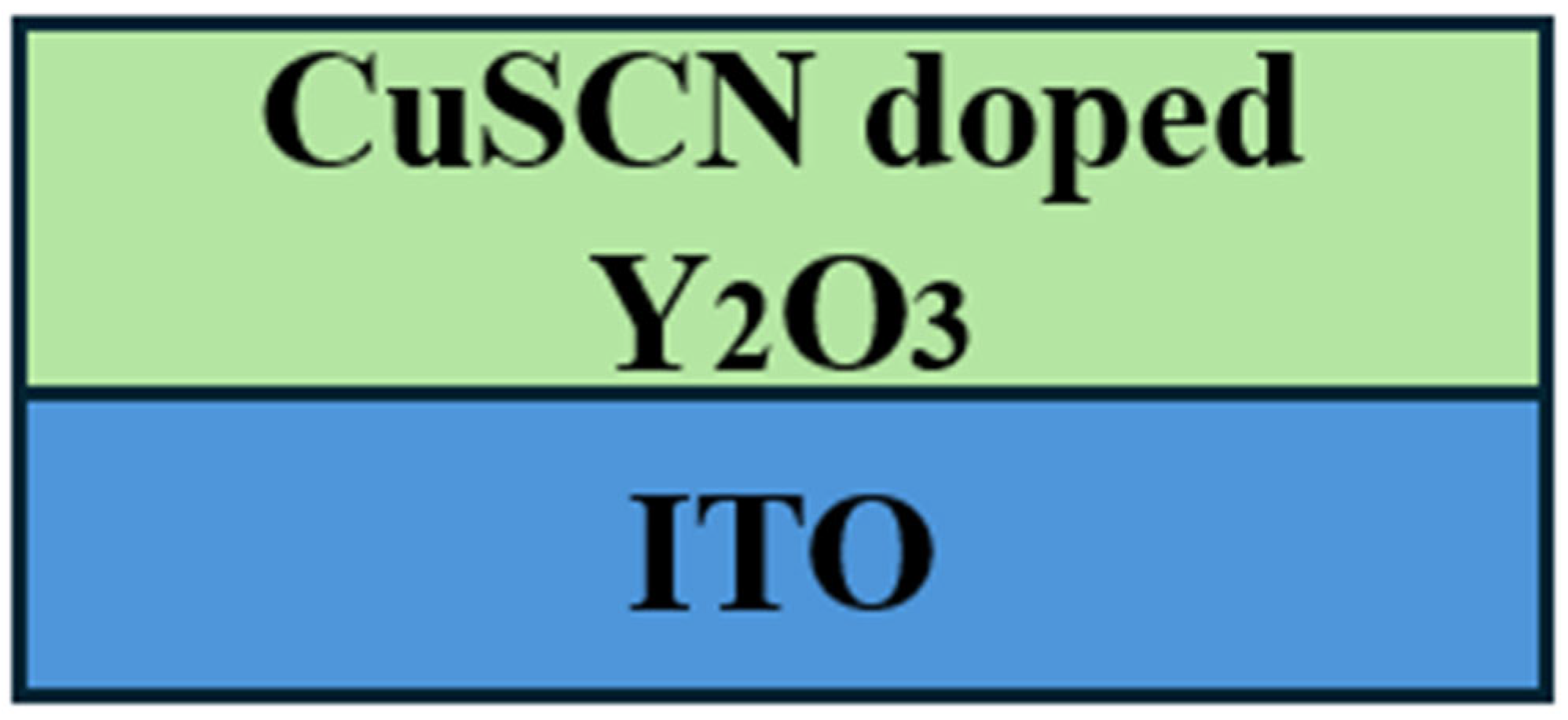
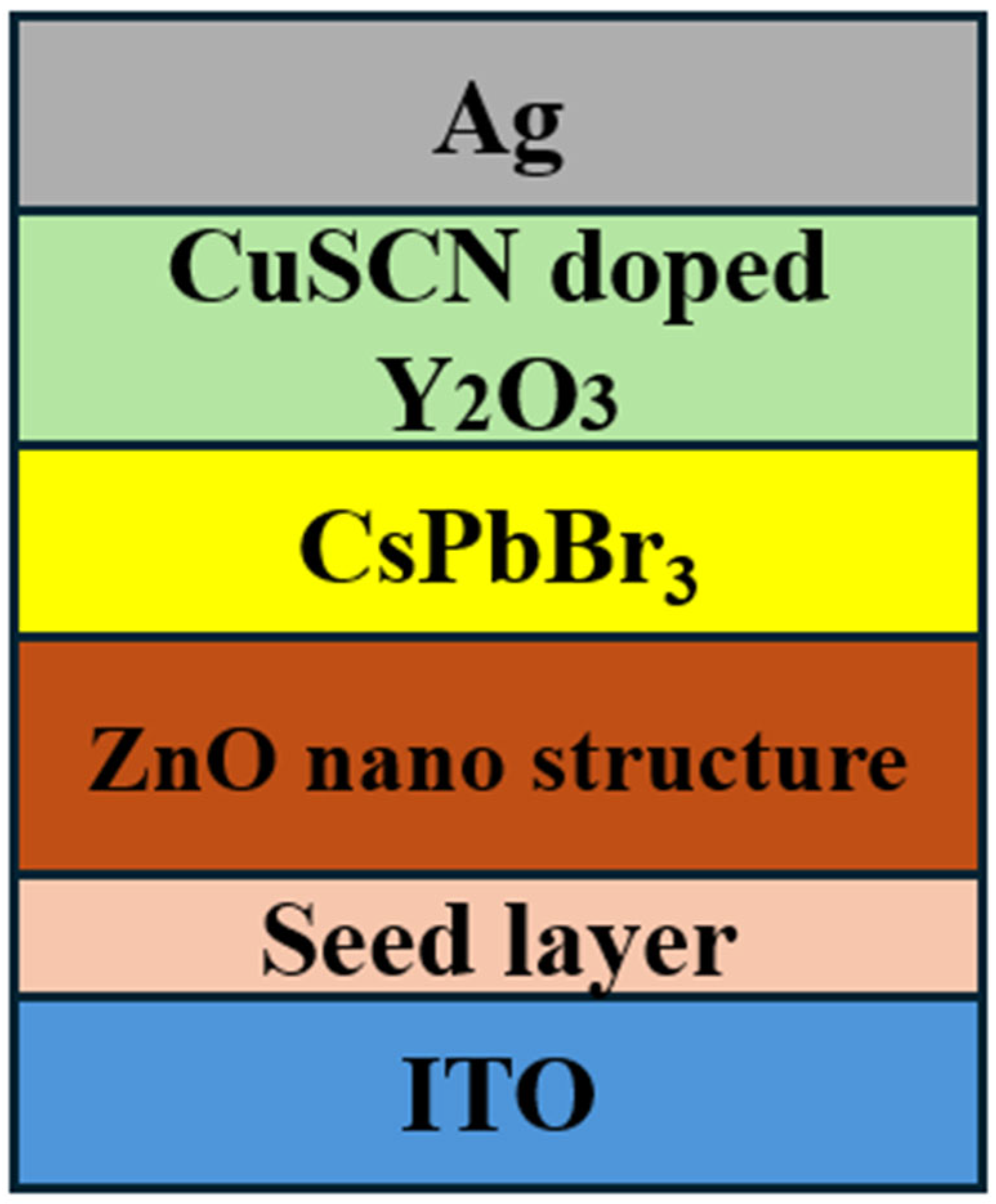
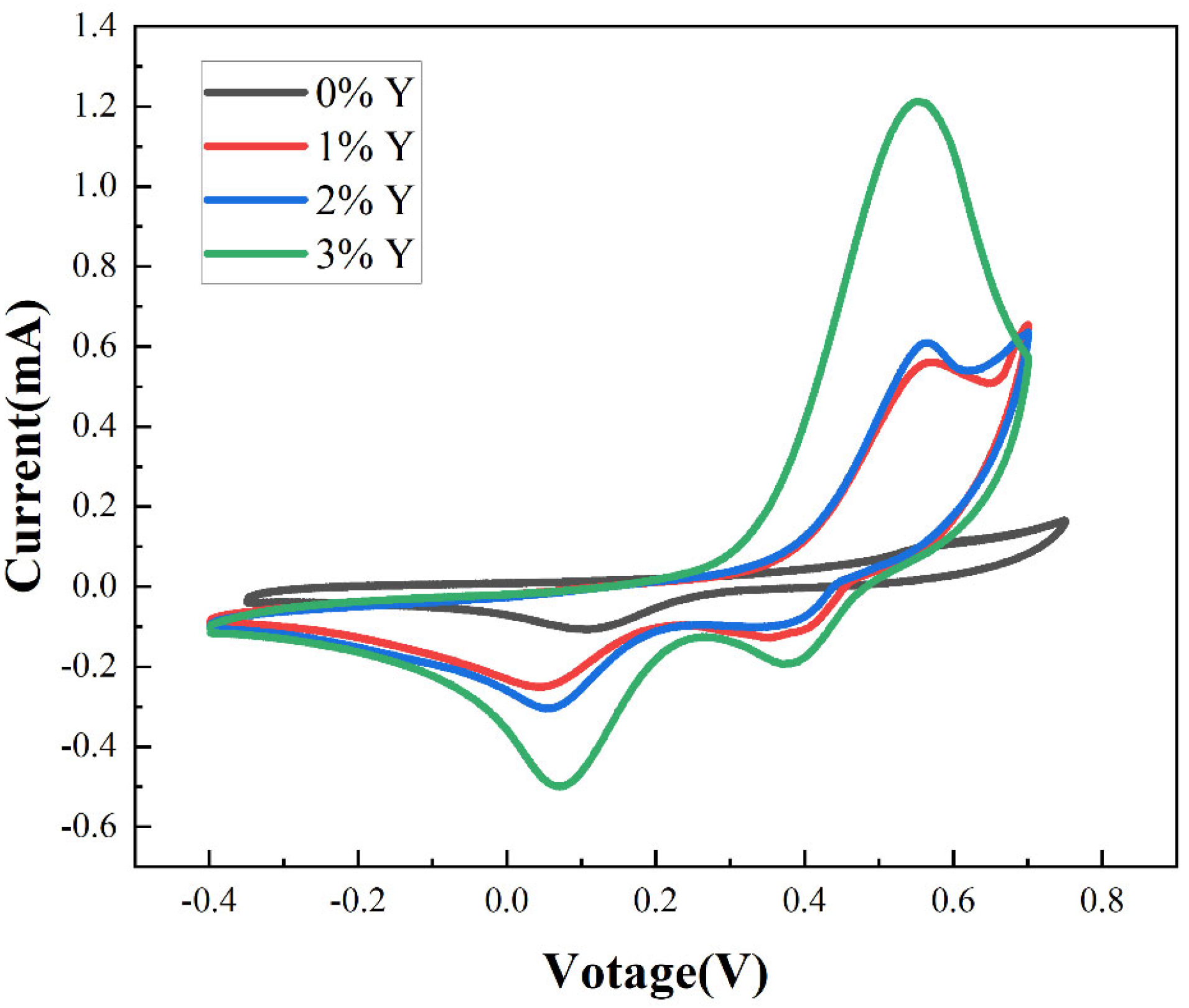
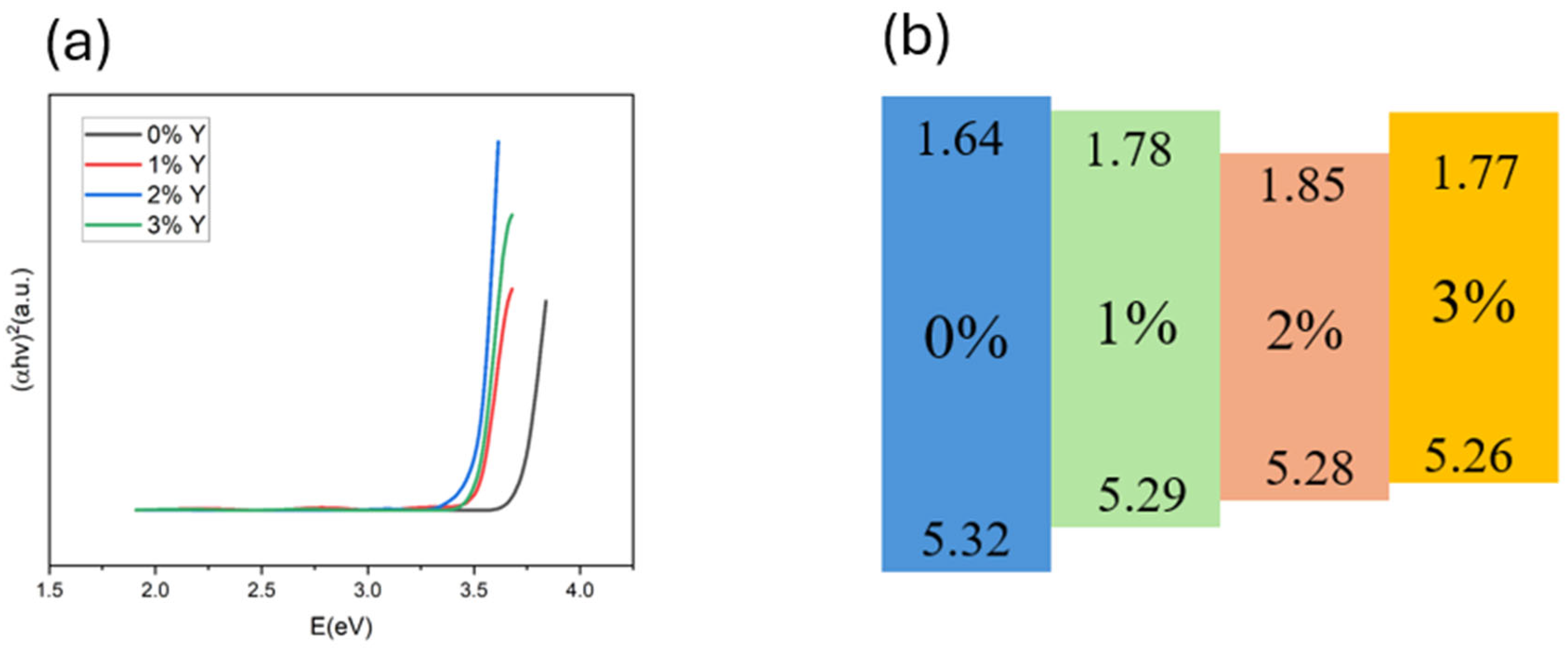
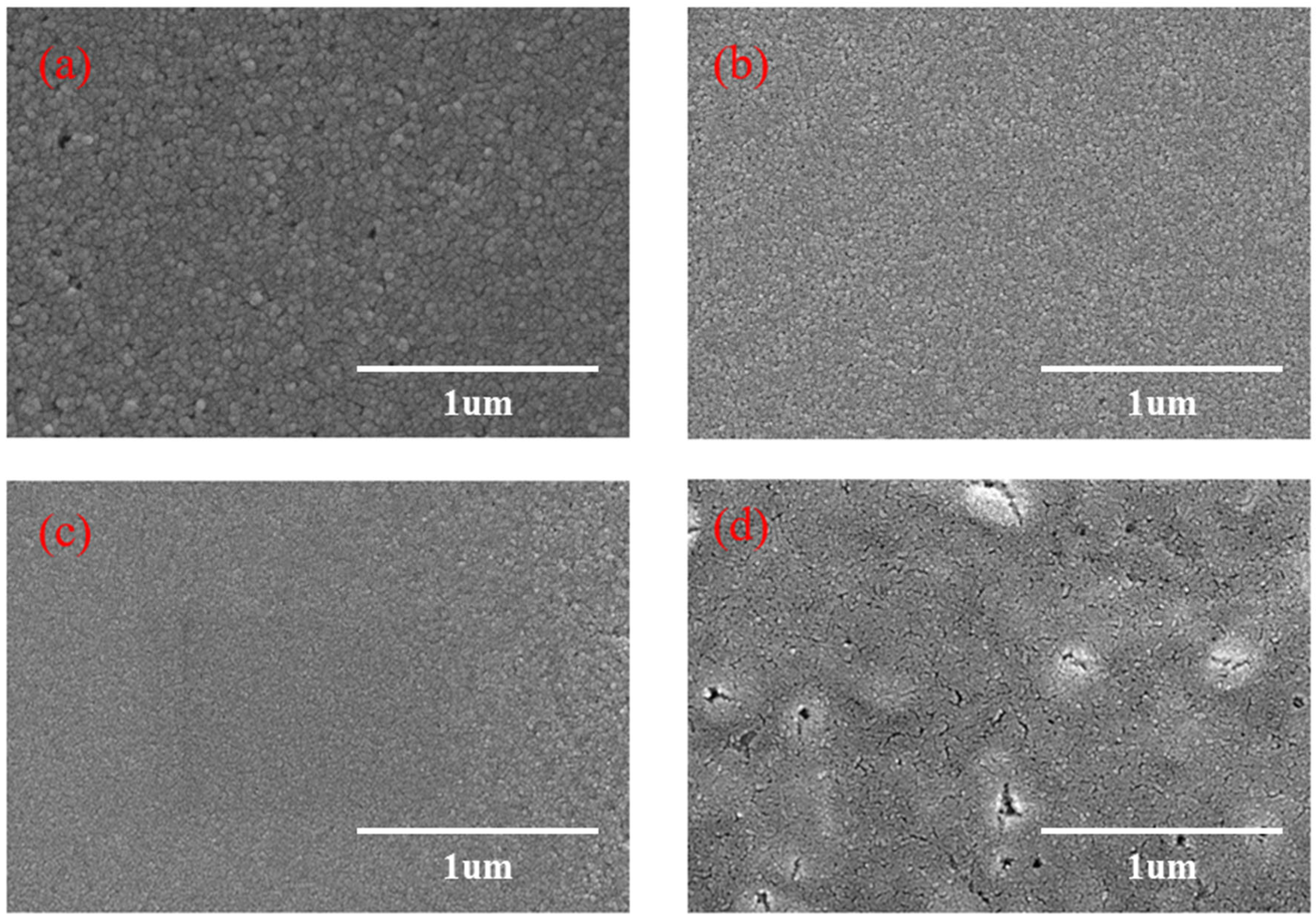
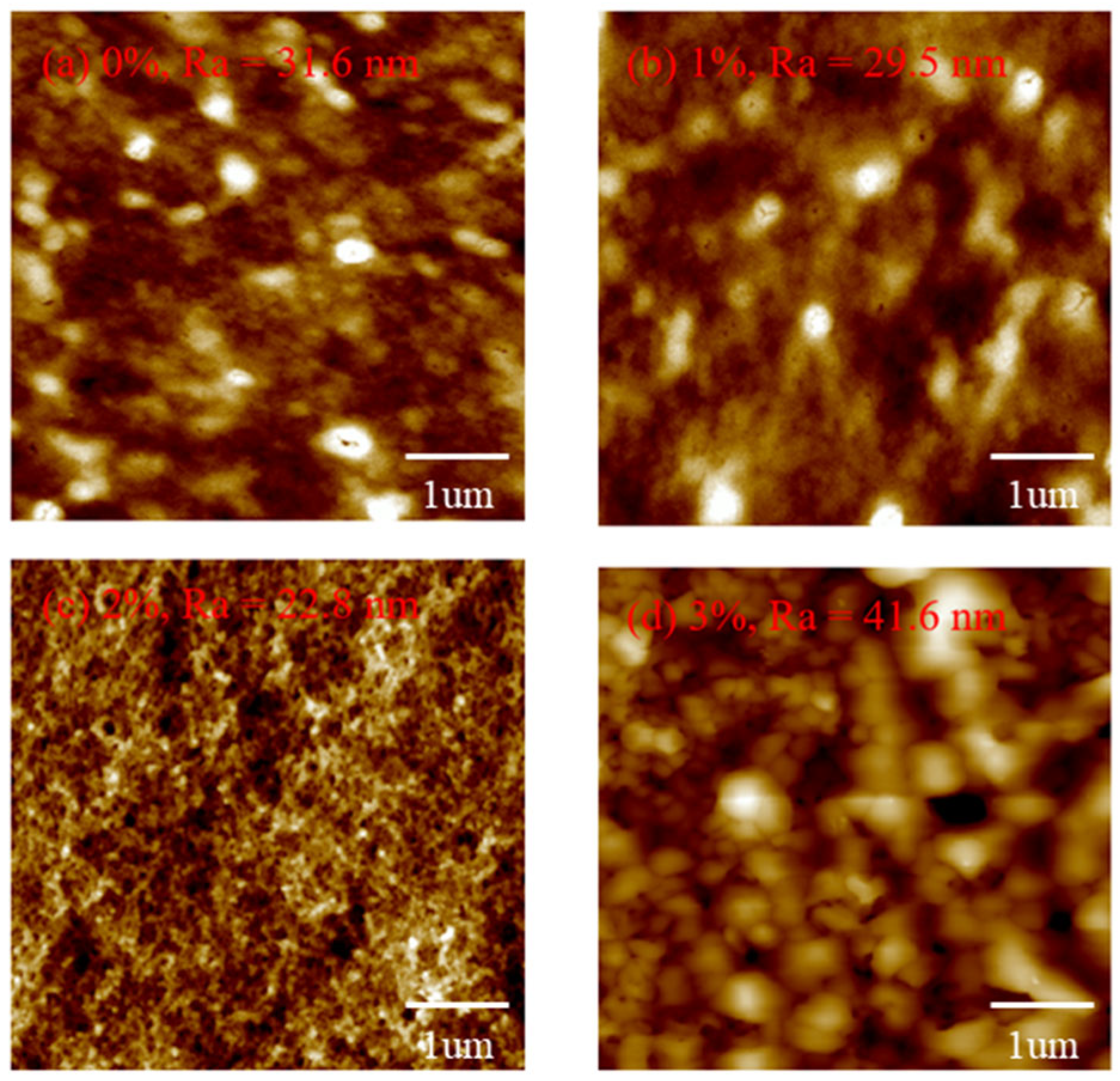
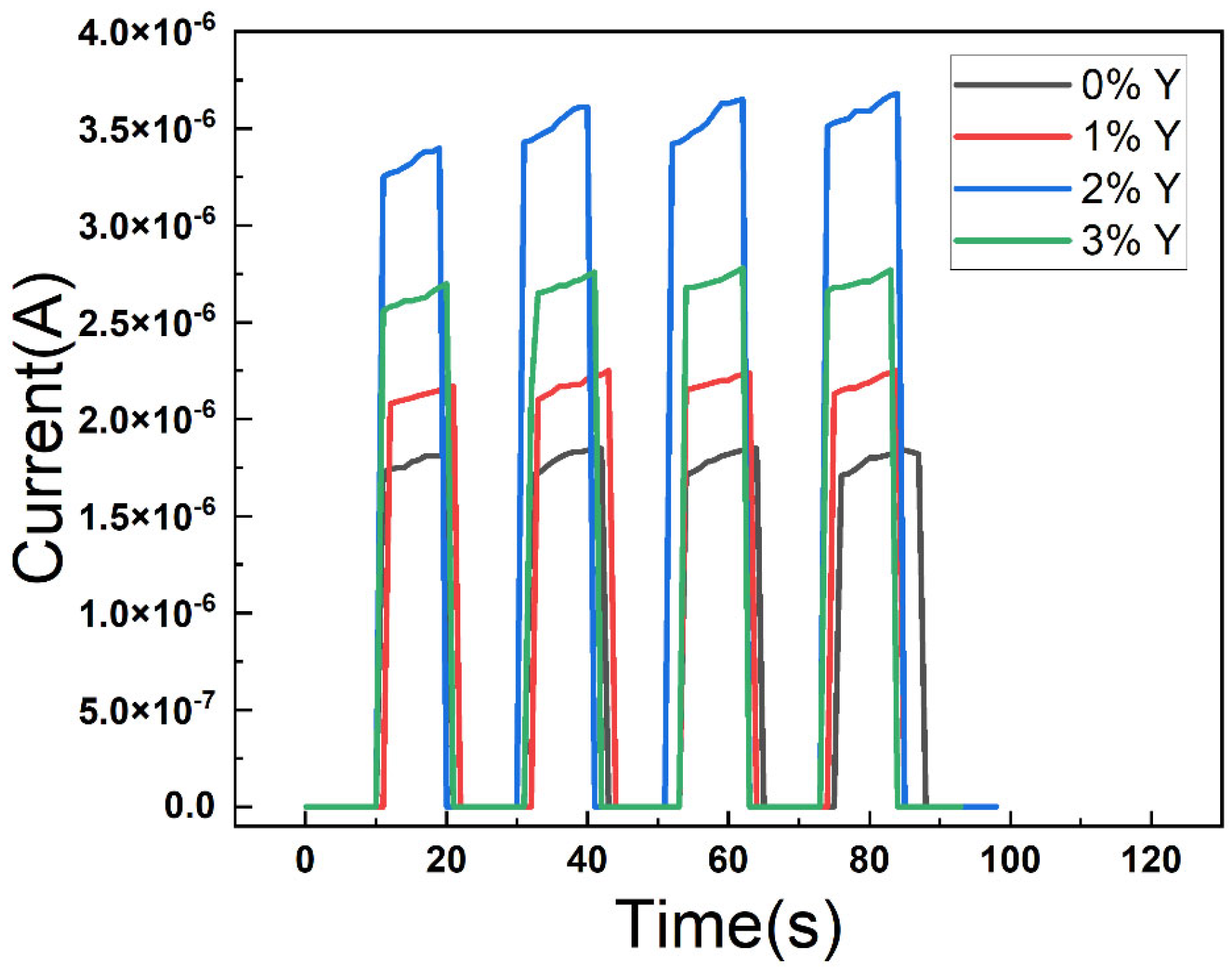
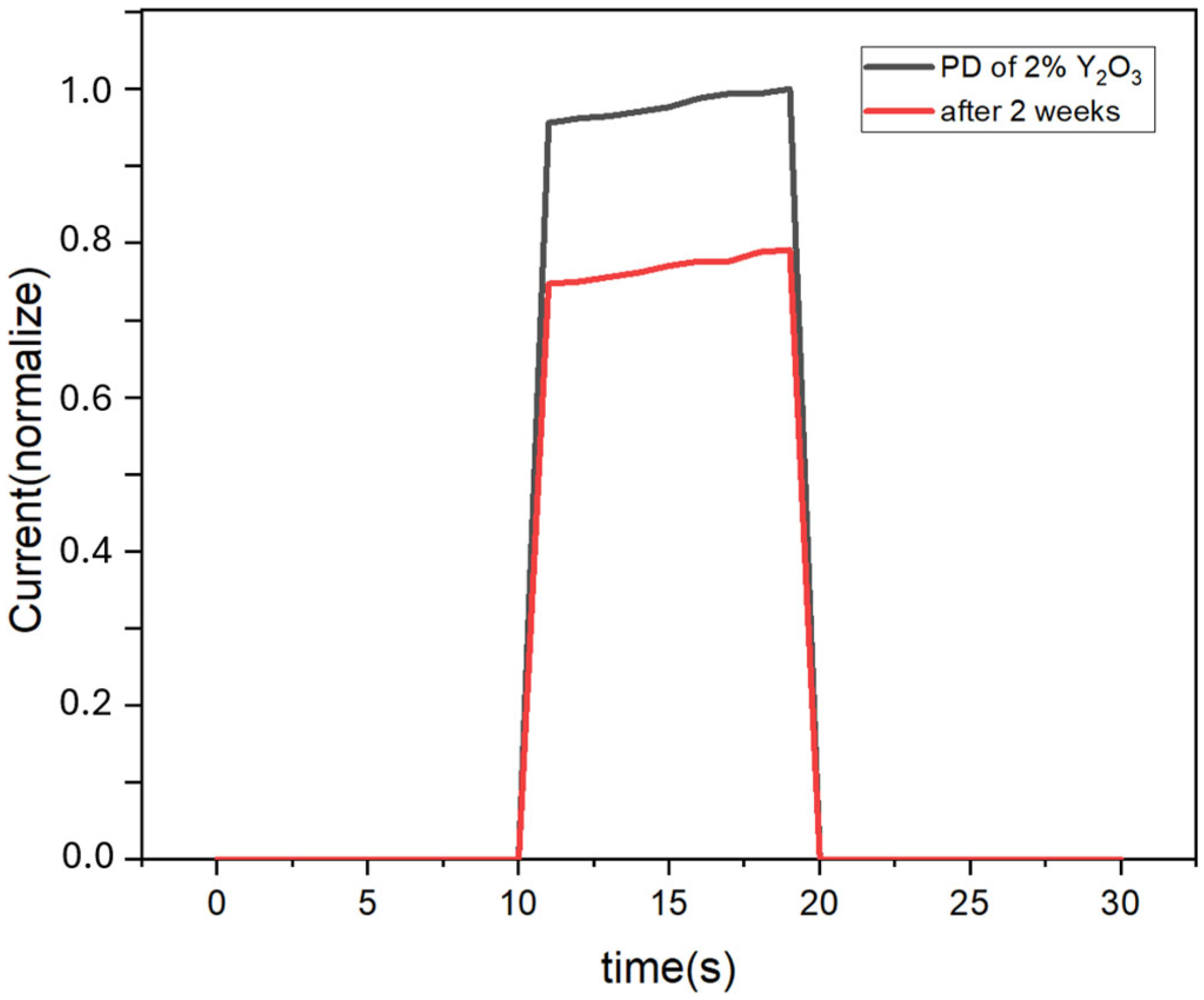
| Doped Ratio | Eox | Eg (eV) | Valence Band Edge (eV) | Conduction Band Edge (eV) | Conductivity (S cm−1) |
|---|---|---|---|---|---|
| 0% | 0.60 | 3.68 | 5.32 | 1.64 | 218 |
| 1% | 0.57 | 3.51 | 5.29 | 1.78 | 516 |
| 2% | 0.56 | 3.43 | 5.28 | 1.85 | 764 |
| 3% | 0.54 | 3.49 | 5.26 | 1.77 | 654 |
| Doping Ratio | Cu (at.%) | S (at.%) | C (at.%) | N (at.%) | Y2O3 (at.%) |
|---|---|---|---|---|---|
| 0% | 19.61 | 14.9 | 41.06 | 23.73 | 0 |
| 1% | 9.74 | 6.23 | 38.42 | 44.6 | 1.01 |
| 2% | 9.25 | 6.1 | 38.33 | 44.21 | 2.10 |
| 3% | 8.21 | 5.96 | 38.3 | 44.7 | 2.83 |
| Y2O3 | Light Current (μA) | Dark Current (pA) | On/Off Ratio (106) | Rise Time (ms)/Fall Time (ms) | Responsivity (mA/W) | Detectivity (1012 Jones) |
|---|---|---|---|---|---|---|
| 0% | 1.26 | 1.36 | 0.926 | 26/22 | 452 | 1.37 |
| 1% | 2.17 | 1.57 | 1.38× | 23/19 | 521 | 1.47 |
| 2% | 3.51 | 1.42 | 2.47× | 9/5 | 685 | 2.03 |
| 3% | 2.62 | 1.52 | 1.72× | 20/17 | 586 | 1.68 |
| On/Off Ratio | Responsivity (mA/W) | Rise Time /Fall Time | Detectivity (Jones) | |
|---|---|---|---|---|
| ITO/ZnO/CsPbBr3/CuSCN mixing Y2O3/Ag [This work] (0v@360 nm) | 2.47 × 106 | 685 | 9 ms /5 ms | 2.03 × 1012 |
| p-GaN/i-Ga2O3/n-Ga2O3 (0v@360 nm) [43] | 1.88 × 104 | 49 | 7 ms /19 ms | 1.22 × 1012 |
| Graphene/γ-Ga2O3/SiC (0v@250 nm) [44] | 32 | 5.8 | 30 ms /196 ms | 7.6 × 1010 |
| Graphene/MgZnO/SiC (0v@260 nm) [45] | 226.4 | 2.64 | 78.2 ms /162 ms | - |
| ITO/ZnO/CsPbBr3/CuSCN/Ag [This work] (0v@360 nm) [40] | 3.96 × 106 | 497.9 | <10 ms | 6.81 × 1010 |
| ZnO NRs/CsPbBr3/MoO3/Au [46] | 450 | 300 | 200 ms/500 ms | - |
Disclaimer/Publisher’s Note: The statements, opinions and data contained in all publications are solely those of the individual author(s) and contributor(s) and not of MDPI and/or the editor(s). MDPI and/or the editor(s) disclaim responsibility for any injury to people or property resulting from any ideas, methods, instructions or products referred to in the content. |
© 2025 by the authors. Licensee MDPI, Basel, Switzerland. This article is an open access article distributed under the terms and conditions of the Creative Commons Attribution (CC BY) license (https://creativecommons.org/licenses/by/4.0/).
Share and Cite
Wang, J.-H.; Chen, B.-C.; Chu, S.-Y. The Fabrication and Characterization of Self-Powered P-I-N Perovskite Photodetectors Using Yttrium-Doped Cuprous Thiocyanate. Micromachines 2025, 16, 666. https://doi.org/10.3390/mi16060666
Wang J-H, Chen B-C, Chu S-Y. The Fabrication and Characterization of Self-Powered P-I-N Perovskite Photodetectors Using Yttrium-Doped Cuprous Thiocyanate. Micromachines. 2025; 16(6):666. https://doi.org/10.3390/mi16060666
Chicago/Turabian StyleWang, Jai-Hao, Bo-Chun Chen, and Sheng-Yuan Chu. 2025. "The Fabrication and Characterization of Self-Powered P-I-N Perovskite Photodetectors Using Yttrium-Doped Cuprous Thiocyanate" Micromachines 16, no. 6: 666. https://doi.org/10.3390/mi16060666
APA StyleWang, J.-H., Chen, B.-C., & Chu, S.-Y. (2025). The Fabrication and Characterization of Self-Powered P-I-N Perovskite Photodetectors Using Yttrium-Doped Cuprous Thiocyanate. Micromachines, 16(6), 666. https://doi.org/10.3390/mi16060666






